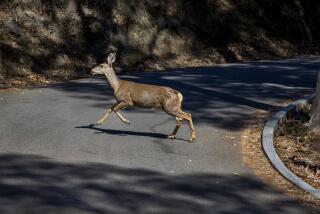Despite Increased Hunts, Deer Buck the Odds and Multiply
- Share via
LEE'S SUMMIT, Mo. — Near tract homes and strip malls, archery hunters in camouflage gear stalk the portly deer that roam here, just outside Kansas City.
This is not a wilderness experience. The hunters are conducting a controlled deer kill in a suburb, one of many calculated attempts to thin the Midwest’s healthy herds of does and bucks this fall.
State wildlife biologists say the white-tailed deer have reached dangerous population peaks in hundreds of urban and rural areas, producing so many fawns and living so long that only non-traditional hunting can bring the herds into balance with humans.
“This is the first time Lee’s Summit has opened up to archery hunting,” said local wildlife manager Steve Cooper. “There are a lot of deer inside the city limits.”
Animal rights groups have opposed some kills, arguing that deer should be trapped alive and relocated. Similar concern spurred a team of scientists that is now testing a contraceptive vaccine for deer.
But state biologists insist that bullets and arrows are the only effective tools for culling herds. That view has led to archery hunts in subdivisions, bait-and-fire sharpshooting, shotgun hunting in otherwise gun-free state parks, and even “handicap hunt” weekends for people in wheelchairs.
“Deer in the Midwest are reproducing all-out,” said Lonnie Hansen, a biologist for the Missouri Department of Conservation. “In a lot of situations they’ve been allowed to get out of hand and wreak havoc.”
Even hunting opponents agree that the deer population explosion has created a nightmare for motorists, farmers, endangered flora, park systems and airports.
On Illinois roads last year, a record 16,541 vehicles were damaged by deer that bounded into their paths. In Missouri, farmers lost thousands of dollars in alfalfa crops to hungry herds. Wildflowers have been decimated by herds in Indiana’s Brown County State Park, and deer graze near the runways at the Peoria, Ill., airport.
Each year, more deer hunting permits are issued in Missouri, but the herds have increased by 50% in the past seven years to 800,000 animals. The Ohio herds are growing 10% annually, even though hunters usually kill about one-third of the 400,000 animals during a one-week shotgun season in November.
Paradoxically, people have encouraged deer to multiply. Many deer in the Midwest are descendants of herds released in the 1920s and ‘30s by state conservation agencies to bring back game animals exterminated by hunting in the 1800s.
With plenty of corn and landscaping shrubbery to eat, deer today are “in excellent physical condition,” said Ohio Division of Wildlife biologist Bob Stoll. “There’s no natural stress nutritionally, nor is there any natural competition.”
Home builders in the Chicago area are filling customer orders for houses that are nestled in the woods--a trend that state wildlife expert Paul Shelton said gives deer plenty of room to forage.
“When people spread out, they tend to live where the deer want to live,” Shelton said. “As a result, our methods of controlling deer have had to be innovative.”
In Indiana, an animal rights group filed a lawsuit this fall to block the first controlled hunt in a state park. But courts backed the Department of Natural Resources plan to allow hunting this December in Brown County State Park south of Indianapolis, where deer have left a park-wide “browse line” of dead vegetation.
“In the future we hope we don’t have to do these hunts,” said department spokesman Jon Mitchell. “But that’s the solution for now.”
Contraceptives may be an alternative to kills. At a conference in Denver last month, scientists said they are close to developing the first practical birth-control vaccine for deer--one that would be administered with darts and last one year.
More to Read
Sign up for Essential California
The most important California stories and recommendations in your inbox every morning.
You may occasionally receive promotional content from the Los Angeles Times.













